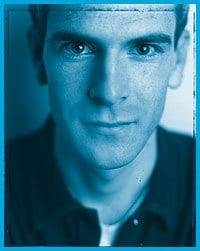Playwright Michael Lewis MacLennan is basking in glory these days.
MacLennan’s The Last Romantics had its world premiere at the National Arts Centre on Apr 1, and critics were unanimous in their praise of this theatrical masterpiece. But he says the play was something new for him.
“I’ve never written a play like it before where people are speaking in different accents and a different place,” says the Vancouver-born MacLennan.
While MacLennan enjoys the recent aftermath of The Last Romantics’ premiere in Ottawa, he certainly hasn’t quit his day job. He’s a talented screenwriter whose credits include Wind at my Back, Anne of Green Gables and Queer as Folk.
“I’m all over the map,” he admits, adding that he’s currently working on opera too. “I like challenging different parts of my brain. Each one offers different challenges and different rewards.”
Though the show Queer as Folk is just wrapping up its third season, its success could not keep MacLennan from the stage with his fourth published play. “I love the theatre too much to give it up. There’s nothing like sitting among an audience watching something you wrote.”
The Last Romantics centres on the real-life stories of Charles Ricketts, the influence behind much of the early collection of the National Gallery of Canada, and Charles Shannon, a gifted painter. The pair’s quasi-gay relationship spans 50 years and two countries (England and Canada) at the turn of the century, when Oscar Wilde made headlines for his arrest.
The historically-based play was a departure for MacLennan, whose other plays Beat the Sunset, Grace and The Shooting Stage are more contemporary. Despite the setting and the costumes, however, MacLennan says The Last Romantics is contemporary in structure, emotion and timing.
“It’s set 100 years ago, but it’s not an old-fashioned play,” he’s quick to explain. “It’s just a good story. And every play I’ve ever written has gay characters or lesbian characters in there. But I don’t write for a gay audience.”
The play unravels as a story of love and hope, which are inextricable from art. But young talent takes a turn for the worse when Wilde is jailed and the artistic careers of Shannon, Ricketts and the famous illustrator Aubrey Beardsley (Steven McCarthy) collapse. To compound the misery, Shannon falls from a ladder and suffers brain damage, halting his ability to paint.
Ricketts, convincingly played by Julian Richings, devotes the rest of his life to making Shannon (Oliver Dennis) “come back” through exposure to art.
“It’s obviously a love story, arguably of unrequited love,” explains MacLennan of Ricketts’ undying devotion to the brain-damaged Shannon. “Through this process of being exposed to art, his brain came back. In reality he doesn’t come back quite so much, but Ricketts did get to see that he’d madea difference.”
Set against a clever stage of revolving doors and pictureless gold frames, the characters act out their often-tortured fight for the preservation of art – be it paintings, illustrations or the written word.
Barbara Gordon and Kate Hennig play the female writing team better known as “Michael Field.” Adding incest to a subtle trans-gender theme, the aunt/niece duo, who travel in the same circles as Ricketts and Shanon, become lovers.
“Just because it happened a long time ago doesn’t mean it wasn’t wild,” says MacLennan of the play’s often blurred line between heterosexuality and homosexuality. “It’s hard to talk in terms of gay. At that time people didn’t really have that construction, until Oscar Wilde was arrested.”
The Last Romantics is loaded with drama and passionate soliloquies, but manages to strike notes of humour with derogatory references to Canada as an artless society with no memory (like Shannon). It also includes strong cameo appearances by Oscar Wilde and MacKenzie King (both played by Michael Hanrahan). The transitions between reality, memory and hallucination are seamless, if frequent, and keep the play undulating from past to present without inducing dizziness.
MacLennan also stays close to historical truth, taking artistic license mostly with chronology.
“Everybody in the play existed,” he explains. “For example, Beardsley was the first art superstar of his time. He illustrated books, they were mass-produced. But almost everything you see is true. The less believable it seemed, the more likely that it happened.”
Hopefully, MacLennan’s busy schedule won’t keep him far from Ottawa. The Last Romantics was his first play produced in this city, but it was not the city’s first time seeing MacLennan.
“I came out in Ottawa,” he reminisces. “At a bar called Top Drawer. They were playing It’s Raining Men when I got to the second floor.”
* Last Romantics plays at the National Arts Centre through Sun, Apr 12. Tickets are available at the NAC box office or through Ticketmaster at 755-1111.

 Why you can trust Xtra
Why you can trust Xtra


